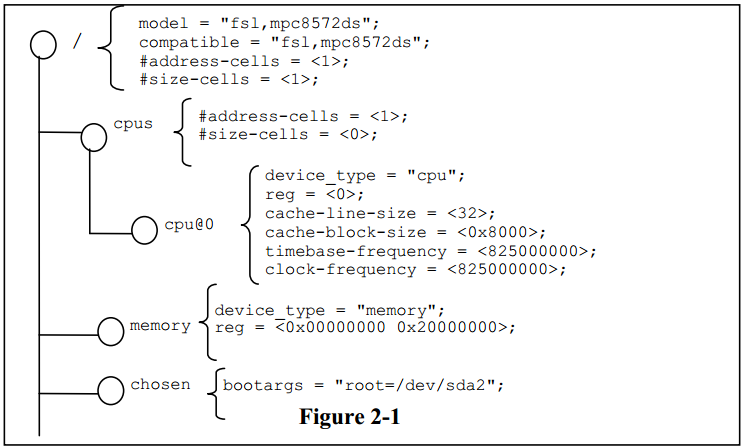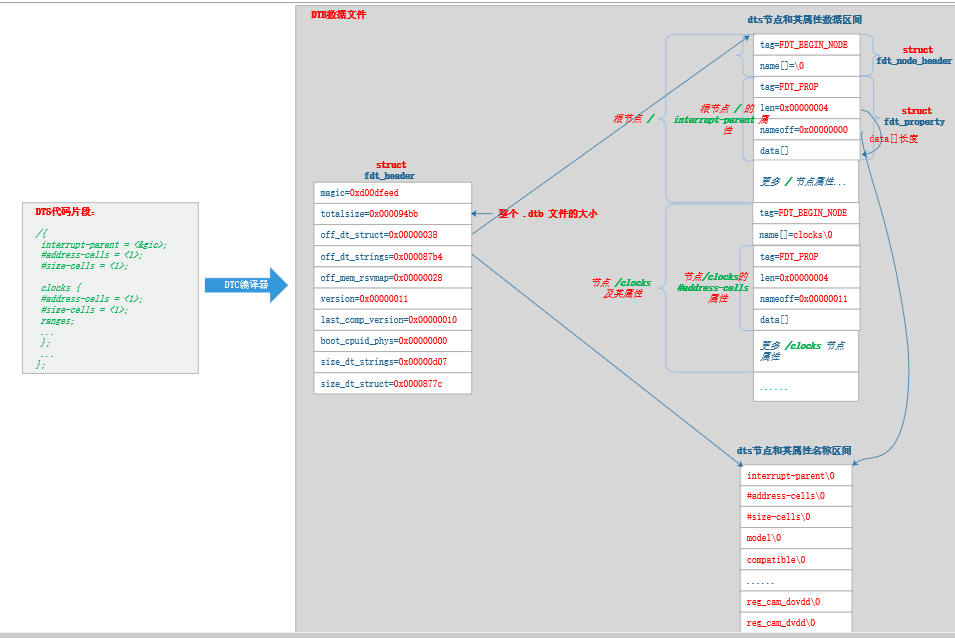Linux设备树简析
| 阿里云国内75折 回扣 微信号:monov8 |
| 阿里云国际,腾讯云国际,低至75折。AWS 93折 免费开户实名账号 代冲值 优惠多多 微信号:monov8 飞机:@monov6 |
1. 前言
限于作者能力水平本文可能存在谬误因此而给读者带来的损失作者不做任何承诺。
2. 设备树的来源
在 Linux 中每个设备驱动管理一组设备数据类似面向对象编程中类和其实例对象的关系。一段时间以来这些设备数据硬编码在内核中导致了内核代码的急剧膨胀(尤其是在ARM架构下)同时影响了维护的便利性。社区总瓢把子 Linus 对此表达了强烈的不满要求整改。针对该问题社区经过一系列地讨论引入了设备树。
设备树是数据驱动逻辑思想即数据与逻辑分离的一个典型应用。通过将设备数据从内核代码迁移到设备树文件(.dts)中然后经由 DTC(Device Tree Compiler) 编译器将设备树文件 .dts 编译成 DTB(Device Tree Blob) 数据文件内核通过对 DTB 数据文件的解析展开最终以展开的设备树为基础创建设备驱动的设备对象。我们用下图来描述整个过程
dtc unflatten_device_tree() of_platform_populate()
.dts ---> .dtb ----------------------> 设备树 of_root --------------------> 创建驱动设备对象
3. 设备树文件的创建
按 《Power_ePAPR_APPROVED_v1.1.pdf》规范文档定义的语法根据系统中实际硬件设备的拓扑构建设备树文件。
Linux 内核的设备树文件按不同的硬件架构和硬件组织定义在内核源码目录 arch/arch-XXX/boot/dts/* 下。
设备树文件组织成树形结构只有1个根节点。如

4. 设备树文件的编译
设备树文件 .dts 经由内核代码目录下的编译器 scripts/dtc/dtc 编译成 .dtb 文件
dtc
.dts -----> .dtb
5. 设备树的展开
BootLoader 将设备树数据文件 .dtb 在内存中的物理地址传递给内核内核解析该数据文件然后展开它具体代码流程如下
start_kernel()
setup_arch()
unflatten_device_tree()
/* 将 .dtb 展开为以 of_root 为根的设备树 */
__unflatten_device_tree(initial_boot_params, NULL, &of_root,
early_init_dt_alloc_memory_arch, false)
/* 第1遍计算设备树展开后的大小 */
size = unflatten_dt_nodes(blob, NULL, dad, NULL);
/* 为展开后的设备树分配空间: 额外4字节存储展开后设备树的魔数 */
mem = dt_alloc(size + 4, __alignof__(struct device_node));
/* 在最后4字节存储展开后设备树的魔数 */
*(__be32 *)(mem + size) = cpu_to_be32(0xdeadbeef);
/* 第2遍做设备树实际的展开动作 */
unflatten_dt_nodes(blob, mem, dad, mynodes)
for (offset = 0;
offset >= 0 && depth >= initial_depth;
offset = fdt_next_node(blob, offset, &depth)) {
populate_node(blob, offset, &mem, ...)
/* 分配节点空间 */
struct device_node *np = unflatten_dt_alloc(mem, sizeof(struct device_node) + allocl, ...);
of_node_init(np)
kobject_init(&node->kobj, &of_node_ktype);
node->fwnode.ops = &of_fwnode_ops;
/* 展开节点属性 */
populate_properties(blob, offset, mem, np, pathp, dryrun);
}
通过上面的代码分析可以将 .dts 经 dtc 编译器生成的 .dtb 数据文件的结构总结如下图

其中.dtb 文件头部用数据结构 struct fdt_header 描述
struct fdt_header {
fdt32_t magic; /* .dtb文件魔数: 0xd00dfeed */
fdt32_t totalsize; /* .dtb文件字节数总大小 */
fdt32_t off_dt_struct; /* .dts 节点和属性数据区间偏移 */
fdt32_t off_dt_strings; /* .dts 节点属性名区间偏移 */
fdt32_t off_mem_rsvmap; /* .dts 保留内存定义区间偏移 */
fdt32_t version; /* format version */
fdt32_t last_comp_version; /* last compatible version */
/* version 2 fields below */
fdt32_t boot_cpuid_phys; /* Which physical CPU id we're
booting on */
/* version 3 fields below */
fdt32_t size_dt_strings; /* .dts 节点属性名区间字节数大小 */
/* version 17 fields below */
fdt32_t size_dt_struct; /* .dts 节点和属性数据区间字节数大小 */
};
dts 设备树节点数据以 struct fdt_node_header 描述展开后以 struct device_node 描述
struct fdt_node_header {
fdt32_t tag; /* 节点 tag: FDT_BEGIN_NODE */
char name[0]; /* 节点名称以 \0 结尾 */
};
struct device_node {
const char *name;
const char *type;
phandle phandle; /* dts 节点的句柄经常在节点间相互引用时使用。通常由 dtc 编译器隐式添加 */
const char *full_name; /* dts 节点全路径名 */
struct fwnode_handle fwnode;
struct property *properties; /* dts 属性节点 */
struct property *deadprops; /* removed properties */
struct device_node *parent; /* dts 父节点 */
struct device_node *child; /* dts 子节点 */
struct device_node *sibling; /* dts 兄弟节点 */
struct kobject kobj;
unsigned long _flags;
void *data;
...
};
dts 设备树节点属性数据以 struct fdt_property 描述展开后以 struct property 描述
struct fdt_property {
fdt32_t tag; /* FDT_PROP */
fdt32_t len; /* data[] 的长度 */
fdt32_t nameoff; /* 节点属性名称偏移 */
/*
* 节点属性值, 如有 dts 定义
* /{
* model = "FriendlyElec NanoPi-M1-Plus";
* ......
* };
* 则 data[] 的值为 FriendlyElec NanoPi-M1-Plus\0
*/
char data[0];
};
struct property {
char *name; /* dts 节点属性名称 */
int length; /* dts 节点属性数据长度: 即 @value 长度 */
void *value; /* dts 节点属性数据长度为 @length */
struct property *next; /* dts 节点的下一属性 */
unsigned long _flags;
unsigned int unique_id;
struct bin_attribute attr;
};
6. 创建设备树节点的设备对象
以章节 5. 设备树的展开 展开的设备树为基础内核创建设备对象、并绑定到对应的驱动其具体流程如下
/* 启动内核初始化线程 */
start_kernel()
rest_init()
kernel_thread(kernel_init, NULL, CLONE_FS)
/* 进入内核初始化线程 */
kernel_init()
kernel_init_freeable()
...
of_platform_default_populate_init()
of_platform_default_populate(NULL, NULL, NULL)
of_platform_populate(root, of_default_bus_match_table, lookup, parent)
for_each_child_of_node(root, child) {
of_platform_bus_create(child, matches, lookup, parent, true)
/* 创建 platform bus 设备绑定设备到驱动 */
dev = of_platform_device_create_pdata(bus, bus_id, platform_data, parent);
/* 递归创建 platform bus 设备 */
for_each_child_of_node(bus, child) {
of_platform_bus_create(child, matches, lookup, &dev->dev, strict)
}
of_node_set_flag(bus, OF_POPULATED_BUS);
}
注意到这里并没有为所有 DTS 设备树里的节点创建设备对象。像 i2c 总线上的设备是通过注册 i2c 总线驱动时触发的 i2c client 设备的创建和相应驱动的绑定动作其它的如 mmc 总线设备是通过总线注册或定时扫描完成的从设创建和驱动绑定流程感兴趣的读者可自行阅读相关内核代码。
7. 设备树相关工具
fdtget 读取设备树的内容
fdtput : 写属性数据到 .dtb 文件
fdtdump: 导出设备树
8. 参考资料
《Power_ePAPR_APPROVED_v1.1.pdf》
https://manpages.debian.org/testing/device-tree-compiler/

